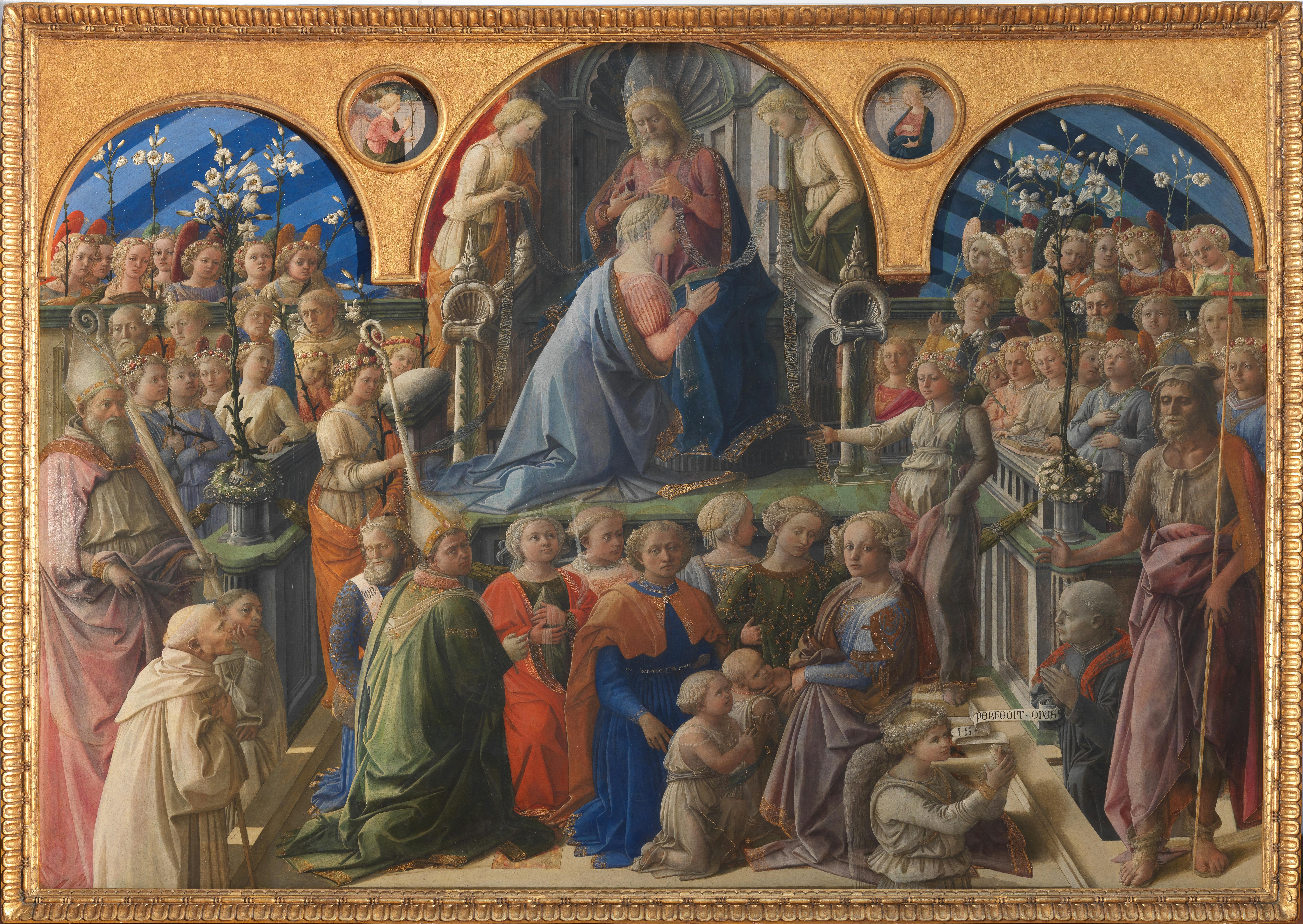Coronation of the Virgin
Filippo Lippi (Florence ca. 1406-Spoleto 1469)
Seated on a throne, God the Father crowns Mary, in the presence of numerous angels and saints. The Virgin, kneeling, humbly accepts the divine will with her hands folded. The theme of Mary presented as a queen frequently recurs in altarpieces intended for churches of female convents and monasteries, as in the case of the painting by Filippo Lippi, which was executed for the high altar of the church of the Benedictine nuns of Saint Ambrose in Florence. The angels near the throne are holding the long priestly stole that God the Father wears over his cloak, while the other angels are carrying white lilies, a flower associated with Mary's purity. The background is formed by blue and light blue concentric bands, probably depicting the heavens which, according to medieval cosmology, made up the celestial sphere. The spatial orchestration is complex, punctuated by the articulated structure of the stone throne, which merges with the architecture.
Among the saints, St. Ambrose can be identified as the bishop standing on the left, the titular saint of the church for which the work was intended, to whom John the Baptist, the patron saint of Florence, corresponds symmetrically on the right. In the foreground, there is a whole family of martyrs killed at the time of Christian persecution under the Roman Empire, namely Saint Eustace, wearing a blue robe and orange mantle, together with his wife Theopista and their sons Theopisto and Agapius.
The patron of the work is depicted while praying at the feet of the Baptist, clearly identifiable by the scroll that the angel is unrolling in front of him, on which is written 'IS... PERFECIT OPUS' (He did the work). According to the documents, he was the canon Francesco di Antonio Maringhi, procurator of the monastery of Saint Ambrose. The altarpiece, painted by Filippo Lippi for more than 400 gold florins, was completed in 1447 thanks to the conspicuous testamentary bequest of the patron, who died in 1441. Under the frame, there is an inscription with the name 'FRATER FILIPPUS'. At the time, Filippo Lippi was a famous painter, and was allowed to practice his profession despite his status of Carmelite friar at the Carmine Convent in Florence. In this work, he apparently celebrated himself by depicting his figure in the background on the left, in the role of a kneeling friar dressed in white with dark hair, who is looking towards us. As attested by the documents, Fra' Filippo employed some collaborators in order to cope with the large amount of work: Fra Diamante, Piero di Lorenzo, and Bartolomeo di Giovanni Corradini were among those who participated in the execution of this altarpiece.
The work, destined for the high altar of the Church of St. Ambrose, presents a composition of figures which appear a little squat and sprouting from below. These were optical expedients specifically designed by Filippo Lippi to reproduce the point of view of the Benedictine nuns from the nearby monastery, who contemplated the sacred image from the choir reserved for them, which in the church was located in a higher position. The altarpiece had a historiated predella, of which only a compartment depicting a miracle of St. Ambrose in Berlin has been preserved to these days (Staatliche Museen, Gemäldegalerie, inv. 95B). The current frame is modern.
Filippo Lippi’s work, later moved to the sacristy, was stolen after 1755 and became part of the collection of art dealer Angelo Volpini, from whom it passed to the Galleria dell'Accademia in Florence in 1813. It has been preserved at the Uffizi since 1913.
J. Ruda, Fra Filippo Lippi, Londra 1993, cat. n. 37; M. Holmes, Fra Filippo Lippi. The carmelite painter, New Haven, London 1999, pp. 223-231; L. Bortolotti, Lippi, Filippo, in Dizionario biografico degli italiani, 65, Roma 2005, https://www.treccani.it/enciclopedia/filippo-lippi_%28Dizionario-Biografico%29/
